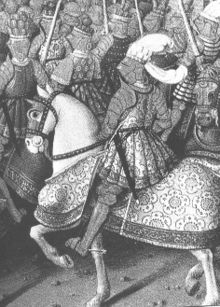
Bases (fashion)
Encyclopedia

Doublet (clothing)
A doublet is a man's snug-fitting buttoned jacket that is fitted and shaped to the man's body which was worn in Western Europe from the Middle Ages through to the mid-17th century. The doublet was hip length or waist length and worn over the shirt or drawers. Until the end of the 15th century the...
or a jerkin
Jerkin (garment)
A jerkin is a man's short close-fitting jacket, made usually of light-colored leather, and often without sleeves, worn over the doublet in the sixteenth and seventeenth centuries...
vest), generally richly embroidered, worn over the armour of later men-at-arms such as French gendarmes
Gendarme (historical)
A gendarme was a heavy cavalryman of noble birth, primarily serving in the French army from the Late Medieval to the Early Modern periods of European History...
in the late 15th to early 16th century, as well as the plate armour skirt later developed in imitation of cloth bases for supplemental upper-leg protection, worn by men-at-arms for foot combat.
Cloth Bases
Italian armoured cavalry had been wearing bases, with or without a jerkin or vest for the chest as well, since the late 15th century. It appears that French gendarmes picked up the fashion in their interventions in Italy during the Italian WarsItalian Wars
The Italian Wars, often referred to as the Great Italian Wars or the Great Wars of Italy and sometimes as the Habsburg–Valois Wars, were a series of conflicts from 1494 to 1559 that involved, at various times, most of the city-states of Italy, the Papal States, most of the major states of Western...
. Adopted by the French sometime after 1495, the fashion soon spread throughout Europe, and may be seen in illustrations throughout the Italian Wars. Such bases were knee-length and cartridge-pleated. Such skirts eventually evolved into quilted or padded breeches worn in the early 17th century.

